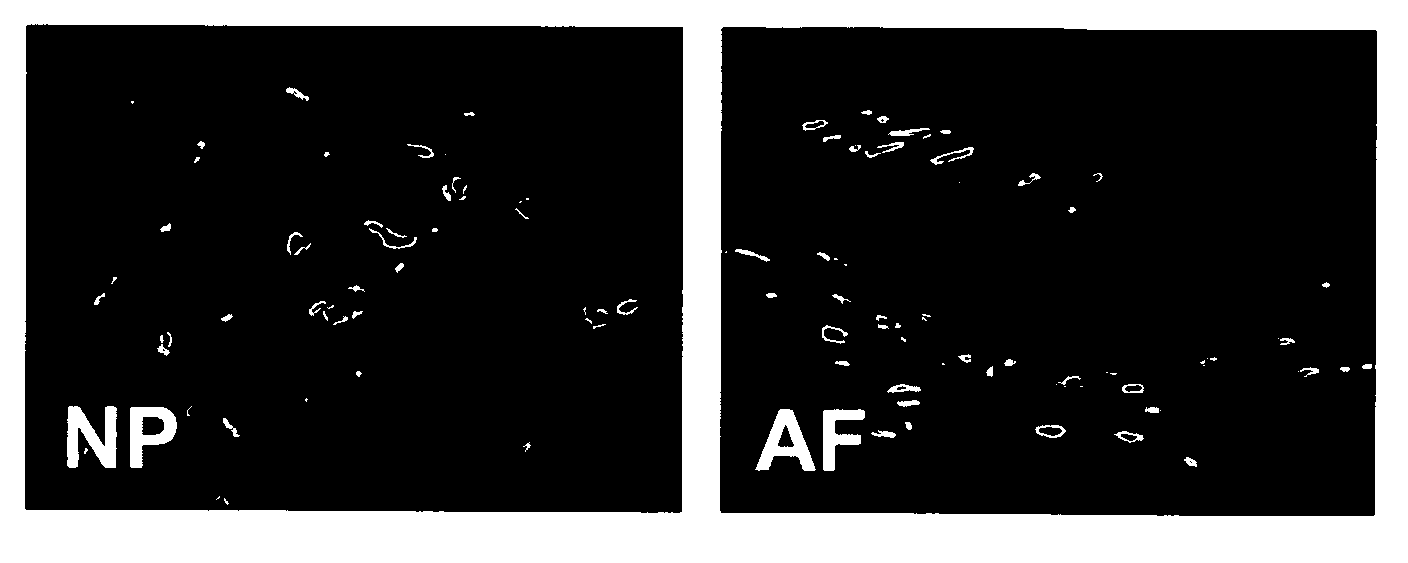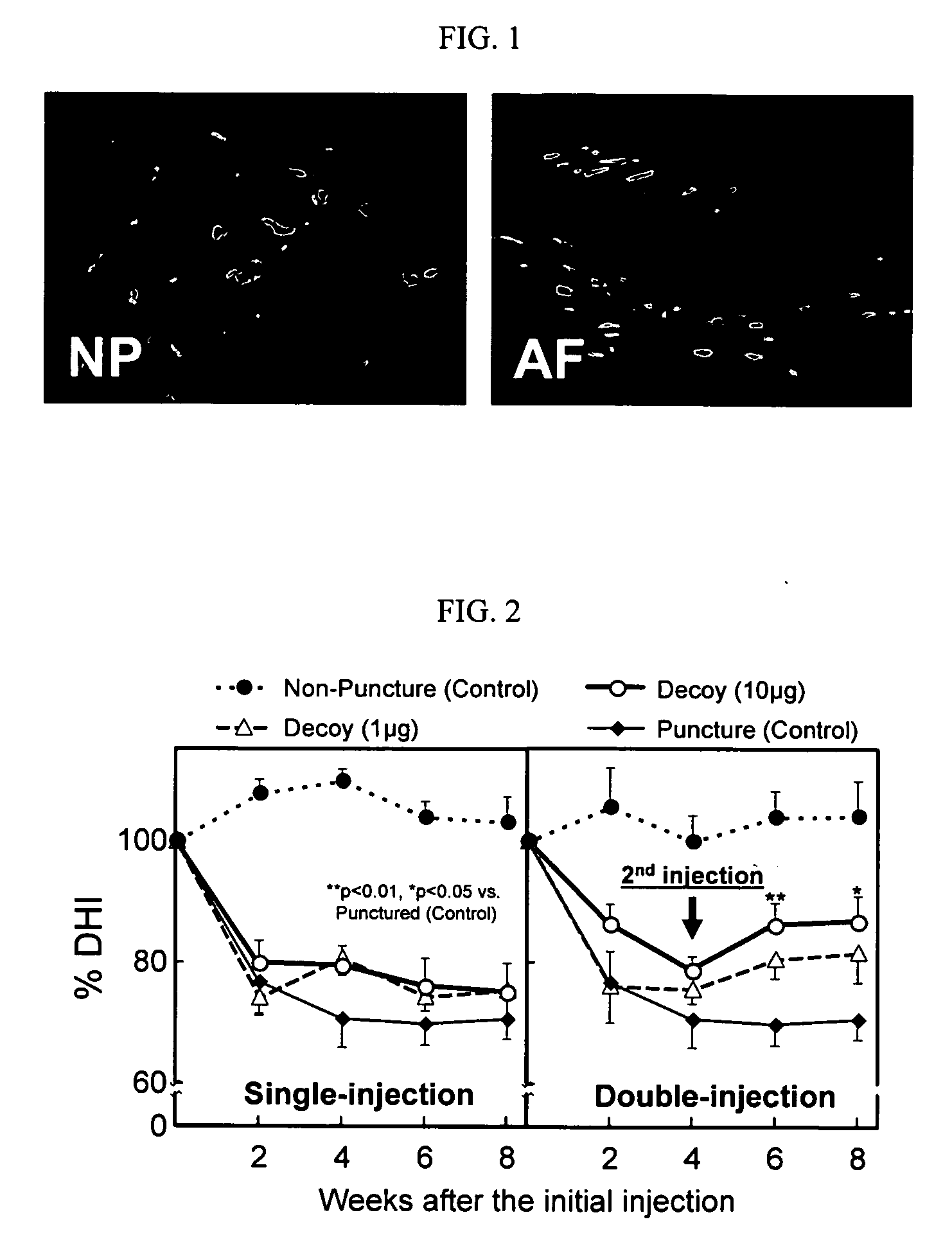Methods and compositions for treating, inhibiting and reversing disorders of the intervertebral disc
a technology of intervertebral disc and disorder, which is applied in the direction of drug compositions, antibody medical ingredients, genetic material ingredients, etc., can solve the problems of degeneration of ivd, limited treatment of intervertebral disc disorders, and limited course of treatment, so as to prevent further pathology
- Summary
- Abstract
- Description
- Claims
- Application Information
AI Technical Summary
Benefits of technology
Problems solved by technology
Method used
Image
Examples
example 1
Reversal of In Vivo Intervertebral Disc Degeneration Following Treatment with a NF-κB Inhibitor
[0055] In this example, an intra-discal injection of naked NF-κB decoy was effective in partially restoring the disc height in a rabbit annular puncture model. Under general anesthesia twenty-four New Zealand White rabbits (3 kg), used with IACUC approval, received an annulus puncture in two non-contiguous lumbar IVDs (L2 / 3 and L4 / 5) with an 18G needle to a 5 mm depth to induce disc degeneration. Discs at L3 / 4 served as non-punctured controls. The rabbits were equally divided into three groups, which included a punctured control, a single-injection and a double-injection group. For the single-injection group, at the initial puncture, 1 μg or 10 μg of NF-κB ODN in 10 μl vehicle was injected using a 28G needle at either the L2 / 3 or L4 / 5 disc. For the double-injection group, four weeks after the initial puncture and injection of decoy, the same dose of NF-κB ODN decoy was injected into the p...
example 2
Decreased Response of In Vitro Intervertebral Disc Cells to IL-1 Following Treatment with a NF-κB Inhibitor
[0060] This example illustrates the use of the methods of the invention to demonstrate that a NF-κB inhibitor when added to intervertebral disc cells significantly reduces the response of the cells to IL-1, a catabolic mediator as measured by the production of MMPs, TIMP-1, IL-6 and NO.
[0061] NP and AF cells from 65-70 yrs old donors were isolated and cultured in alginate beads at 4×106 cells / ml in complete media (DMEM / 10% FBS / gentamicin / 25 μg / ml ascorbic acid), which was changed daily. After five days of pre-culture in complete medium, the beads were cultured in serum-free medium without antibiotics for 24 hrs. The cells were then transfected with naked oligonucleotides comprising a scrambled decoy (SCD) 0.5 μM, a single stranded decoy (SSD) 1 μM, and decoy ODNs (0.5 μM) for four hours. Cells where no oligonucleotide was transfected were used as a control. Following transfec...
example 3
Increase In Proteoglycan Content of Cultured AF and NP Cells Following Treatment with NF-κB Inhibitor
[0064] This example illustrates the use of the methods of the invention to demonstrate that a NF-κB inhibitor when added to intervertebral disc cells significantly increases the proteoglycan content of AF and NP cells during culture.
[0065] NP and AF cells were isolated and pre-cultured in alginate beads in DMEM / 10% FBS media for 14 days. After the pre-culture, the cells were either left untreated (Cont), treated with a single stranded NF-κB oligonucleotide (SSD) 2 μM for six hours, or treated with either 1 μl M (D1) or 10 μM (D10) of a double stranded NF-κB decoy oligonucleotide for six hours. Following each treatment, the cells were further cultured for two or seven days. At the end of the culture, the alginate beads containing the NP and AF cells were digested with papain and the proteoglycan content of the cultured cells was measured by the dimethylmethylene blue dye binding met...
PUM
| Property | Measurement | Unit |
|---|---|---|
| Fraction | aaaaa | aaaaa |
| Mass | aaaaa | aaaaa |
| Mass | aaaaa | aaaaa |
Abstract
Description
Claims
Application Information
 Login to View More
Login to View More - R&D
- Intellectual Property
- Life Sciences
- Materials
- Tech Scout
- Unparalleled Data Quality
- Higher Quality Content
- 60% Fewer Hallucinations
Browse by: Latest US Patents, China's latest patents, Technical Efficacy Thesaurus, Application Domain, Technology Topic, Popular Technical Reports.
© 2025 PatSnap. All rights reserved.Legal|Privacy policy|Modern Slavery Act Transparency Statement|Sitemap|About US| Contact US: help@patsnap.com



